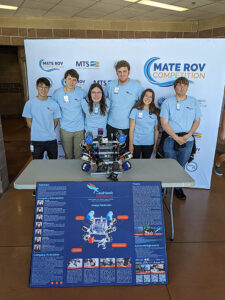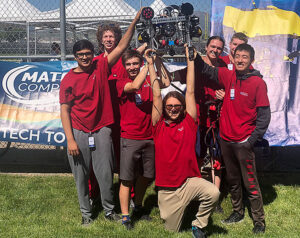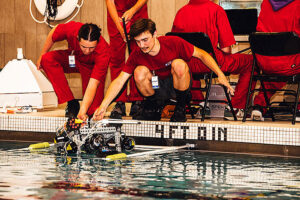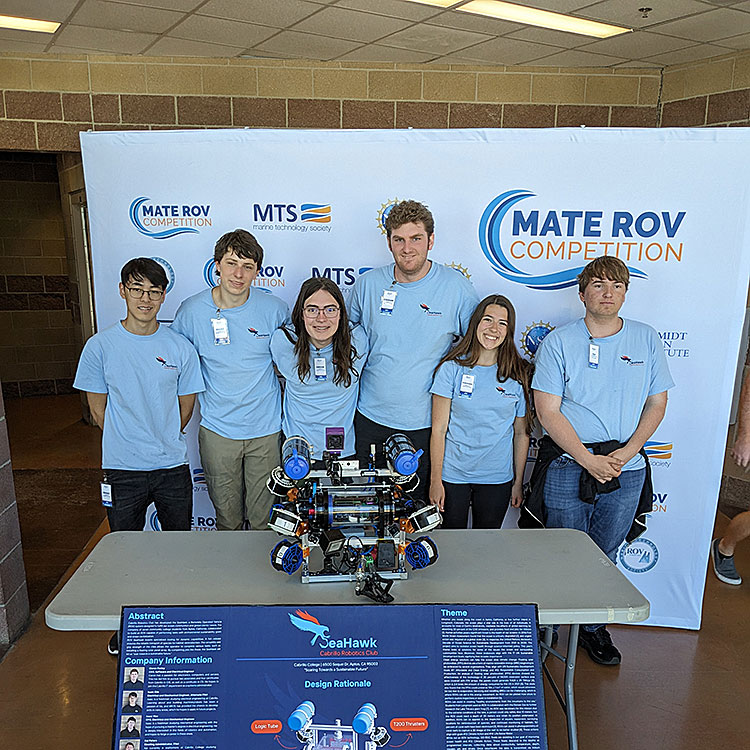For a second straight year, the Cabrillo College Robotics Club won first place in the World MATE ROV Competition, an international underwater robotics competition, this year hosted in Longmont, Colorado.

Student members of the Cabrillo Robotics Team (from left): Isaac Eda, Isaac Wax, Orion Ellefson, Ciaran Farley, Stephanie L’Heureux and Kai Peters.
The Cabrillo Robotics Club, represented by Cabrillo College students Isaac Eda, Isaac Wax, Orion Ellefson, Ciaran Farley, Stephanie L’Heureux and Kai Peters and advised by computer and information systems instructor Mike Matera, earned first place overall in the Pioneer division.
Wax and Farley, who helped Cabrillo win in 2022, teamed with students new to the contest to earn a repeat title.
The Pioneer division is for community colleges, technical colleges and first-time teams from four-year universities.
The Cabrillo Robotics Club with its underwater ROV aptly named SeaHawk again topped five other teams in the division with an overall score of 377.5.
Second-place Lancer Lumineers from Pasadena City College earned 373.
Third-place Southwest Virginia Community College Robotics earned 325.
Teams compete in product demo, engineering presentation, technical documentation, marketing display, secret mission, company spec, corporate responsibility, and safety — with Cabrillo’s team outscored the others in the last two metrics for the win.
The Cabrillo Robotics Club team won the following prizes:
- Pioneer First Place, All-Around Champion Trophy
- One-year membership in the Marine Technology Society
- A $500 Visa gift card sponsored by Schmidt Ocean Institute
- Four T200 thrusters + 4 controllers (one device retails for $236)
Timed near the 25th anniversary of the first rover mission to land on Mars, this was the 21st World Championship of the MATE ROV Competition, attracting teams from 12 countries and 18 American states for the three divisions.
The Explorer division for returning four-year universities attracted 23 teams, and 31 teams qualified for the Ranger division for high schools. There also are divisions for students in elementary and middle school and homeschoolers.
“To win takes teamwork,” said Mike Matera, faculty advisor and CIS instructor. “To perform complex tasks underwater, six students work together on the pool deck, each with an important job to do. Teams are also scored on an oral presentation, on technical documentation and a marketing display. Next year we will compete in the Explorer division against four-year schools. I’m excited to see them rise to the challenge.”
International and regional ROV competitions challenge students to design and build underwater robots to tackle mission tasks based upon real-world applications, highlighting the United Nations Decade of Ocean Science for Sustainable Development and inspiring our global community to create a sustainable future.
The 2023 competition challenged participants to engineer an ROV and the necessary sensors and tooling to, for example, produce clean energy by installing floating solar panels amongst offshore wind farms and ensure healthy environments by monitoring the recovery of seagrass beds – all simulated within the confines of a swimming pool.
Young people who have participated in the MATE ROV competition have gone onto careers as an ROV pilot/electrical engineer, mechanical/ocean engineer and lunar rover driver, to name a few.
The Marine Advanced Technology Education Center was established with a grant from the National Science Foundation to Monterey Peninsula College in 1997. Founded in 2016, MATE Inspiration for Innovation is a 501(c)3 nonprofit created by the MATE Center to support the global MATE ROV Competition.
•••
XAcademy: Fifth in the World
With teams competing from around the globe, Santa Cruz-based XAcademy’s team came in 5th in the MATE ROV World Championship June 22-24 in Longmont, Colorado.
 The X Academy’s Hephaestus Robotics team, one of 32 teams in the high school Ranger class, scored 435 out of a possible 695 points.
The X Academy’s Hephaestus Robotics team, one of 32 teams in the high school Ranger class, scored 435 out of a possible 695 points.
The team was named for the Greek god of metalworking.
The competition tasks students from high schools, community colleges and universities to design, build and test underwater robots to complete simulated real-world missions based on the United Nations Decade of Ocean Science for Sustainable Development goals.
Teams compete in product demonstration, engineering presentation, technical documentation, corporate responsibility, safety, marketing display, and company spec sheet.
The X Academy placed 3rd in engineering presentation, 5th in product demonstration and 5th in technical documentation.
“This has been an amazing experience,” said Kai Herbst, a Kirby School senior. Our team learned skills that are important in a lot of STEM jobs, and we used them to build a great robot.”
 The X Academy’s Hephaestus Robotics team includes students from 5 schools, including Andrew Sylvester, Jordan Weiss-Penzias, Kai Herbst, and Max Chen of Kirby School; Bennet Menzer, Ben Hillard, Salvador Turkie, Samuel Lambert of Santa Cruz High; Max Herrera of Ceiba College Prep; Xander Coomes from Pacific Collegiate School, Ojas and Om Shastri from Los Gatos High.
The X Academy’s Hephaestus Robotics team includes students from 5 schools, including Andrew Sylvester, Jordan Weiss-Penzias, Kai Herbst, and Max Chen of Kirby School; Bennet Menzer, Ben Hillard, Salvador Turkie, Samuel Lambert of Santa Cruz High; Max Herrera of Ceiba College Prep; Xander Coomes from Pacific Collegiate School, Ojas and Om Shastri from Los Gatos High.
Another lesson: “Coming from five different schools, we learned how to build a team and problem-solve when things didn’t always work like we planned,” Herbst said.
Students must organize themselves into mock companies, encouraging them to develop entrepreneurial thinking, business and project management skills.
The 2023 competition challenged students to engineer an ROV and the necessary sensors and tooling to, for example, produce clean energy by installing floating solar panels amongst offshore wind farms and stewarding coral reefs and endangered fish.
Teams performed the simulation within the confines of a swimming pool.
Founded in 1997 at Monterey Peninsula College, the MATE ROV Competition is managed by the Marine Technology Society.
The Hephaestus Robotics team qualified for the World Championship after placing 2nd at the Monterey Bay Regional MATE ROV Competition on April 22 at Watsonville High.
The team competed alongside 2023 World Championship qualifying teams from 12 countries (Scotland, Saudi Arabia, Canada, Egypt, China, Columbia, Norway, Mexico, India, Italy, Macau, and the United States) and 18 American states.
The team designed its ROV, Talos III, and autonomous vertical profiling float, Vulcan II, using Fusion 360. Team members wrote software, designed a custom circuit board, and 3D printed and laser cut numerous custom parts.
Hephaestus Robotics assembled the ROV and float at the X Academy Maker Space in Harvey West.
The team’s sponsor, the X Academy is a Santa Cruz nonprofit offering science tech engineering and math enrichment programs to middle and high school students since 2014 by parent volunteers.
This is the third robotics team sponsored by the XAcademy.
Its teams won 3rd place in the 2022 regional competition and 7th place in the World Championship telepresence division in 2021.
The XAcademy’s flagship program, the Santa Cruz Math Circle, has engaged nearly 400 students from 26 schools in college-level mathematics, serving 30% Latinx students, 40% girls, while providing financial assistance for 25% of its students.
Information: http://www.xacademy.org



